Duvidha
Duvidha : Movie Review
5 stars out of 5 ( Masterpiece - amongst world cinema's most unique films )
Director : Mani Kaul
Hindi (English subtitiles available), 1973
You may pardon my digression in narrating how I came into awareness about 'Duvidha' (Dilemma), on learning that it happened while perusing another slice of the filmic world - an interview of notable Indian film director Rajat Kapoor on the website scroll.in. Early in the talk, which is an illuminating read for aspiring directors, Kapoor says apropos his father "Tell me - which normal guy, who runs a printing press, would go and watch Duvidha and bring his kids along?" I was intrigued - the next morning though time was at a premium, I stole a quick laptop look at the movie. The movie's second image is that of a woman with kohl-smudged eyes and a sari draped over her head, gazing eerily at us while the roughly white-washed room looms over her. It unsettled me within seconds in broad daylight. Days later when I actually settled down to enjoy it in entirety at leisure, it wasn't so much the scare-factor (this is a "ghost movie") as its avant-garde chops that inscribed a lasting impression.
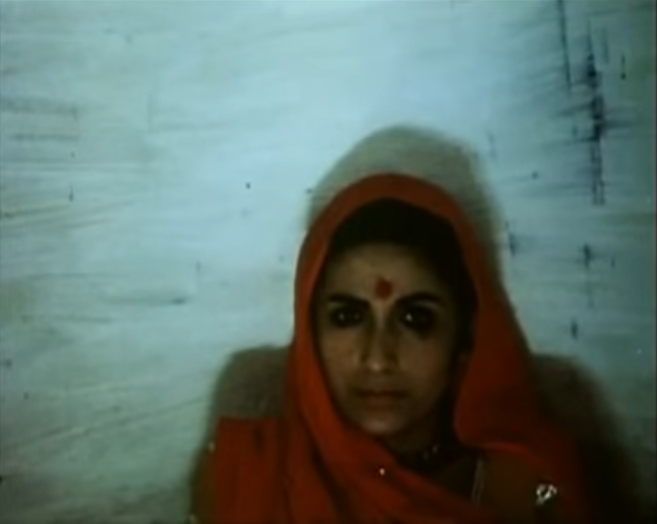
The movie's director Mani Kaul is prominent amongst Indian cinema's enigmas. Why is he an enigma ? It's because he has talent. That can be a dangerous asset to have in Indian cinema if you are a director. If you're a second-rate story-teller with business acumen, you may very well make millions as a film-maker in India, but if nature has cursed you with genuine filmic talent and unshakeable integrity, please emigrate to Europe.
Take another famous 'Mani' in Indian film direction : Mani Ratnam. Ratnam knew from the get-go how to marry his artistic vision with successful commercial vehicles. Kaul could not adjust his caul, but nevermind. When Indian mega-star Rajnikanth's films hit the screens, his fans go crazy dancing and bringing down the theatre's roof. Did Mani Kaul ever manage the same? He sure did. Regarding his Cloud Door (1994) which was screened just once in Mumbai, Ziegler Films tells us : "The single-screening of the film caused an uproar due to its erotic nature and on-screen nudity, and resulted in the police being called in to prevent rioting".
Cut to the considerably less riotous but no less interesting 'Duvidha' - a story about a young couple marooned in the hinterlands of Rajasthan. Rajasthan is famous for its forts and palaces - but we don't see any of that here, in fact we see very less of the outdoors. The action lingers on, in an old white-washed house which cages a young lady (enacted by Raisa Padamsee). Even inside the house, we don't see much of her, swathed as her body is in a sari that is perpetually draped over her head. It's an orthodox household, made worse by the fact that this newly arrived bride is virtually abandoned by her useless young husband. Acceding to an auspicious time-period that mandates him to leave right then to a distant land to trade and make money for five years, he drily consoles his wife that once he returns after five years, they can have all the time and intimacy in the world to themselves.
He's soon gone, but a ghost mimicking him to the fullest, takes his place by fooling the family with a seemingly convincing story. But it tells the young bride the truth. Will she accept this ghost as the perfect physical and mental impersonator of her husband for the next five years ?
One suspects that even if Kaul had directed the same script with a conventional narration, he would have made an interesting picture for the full extent of its crisp 84 minute runtime. But then it might not have made the film uniquely memorable. So he would have thought - what techniques can I use to jazz up this narrative ? How can I do this without boring even the discerning viewer out of her or his skull?
Of all the films I've seen, no other picture comes closer to simulating the effect of reading a comic book (a serious one) and watching a movie at the same time. Kaul subtly detaches video from audio almost always - the characters speak, but the dubbing is purposely left a little desynchronized while the voices are projected a little louder. There are no whispers or any barely audible talk in this movie. The camera, though very careful in aesthetics, is mofussil in its images with high-resolution pictures deliberately unreached for, and that coupled with the speech-bubble-like talk, heightens the illusion of perusing a work of graphic illustrations. Every sentence, with the requisite modulation of course, is like a declarative one. Irony abounds, the magical reality of folklore is tacitly accepted while chaste Sanskrit-centric Hindi is rich in redolence.
Sometimes whilst the dialogues carry on, Kaul shows a static frame, and then switches to another like slowly shuffling picture cards through the montage. All this is done so artfully that it does not come across as gimmicky or disconnected - rather the images and the audio each register with crystalline impact.
Careful visual planning is evident from the very first frame. In an early scene of the ladies welcoming the young marital pair, we see a high overhead shot and then realize it is the best and the most vivid angle for covering the colourful different saris of the ladies all closely grouped together.
When the returned son and father speak, there is an overhead take of their concise confab. This is not because the film-maker has a turban fixation, it's simply because it obtains a good view of the face of the person on the other side, besides the capture being visually striking.
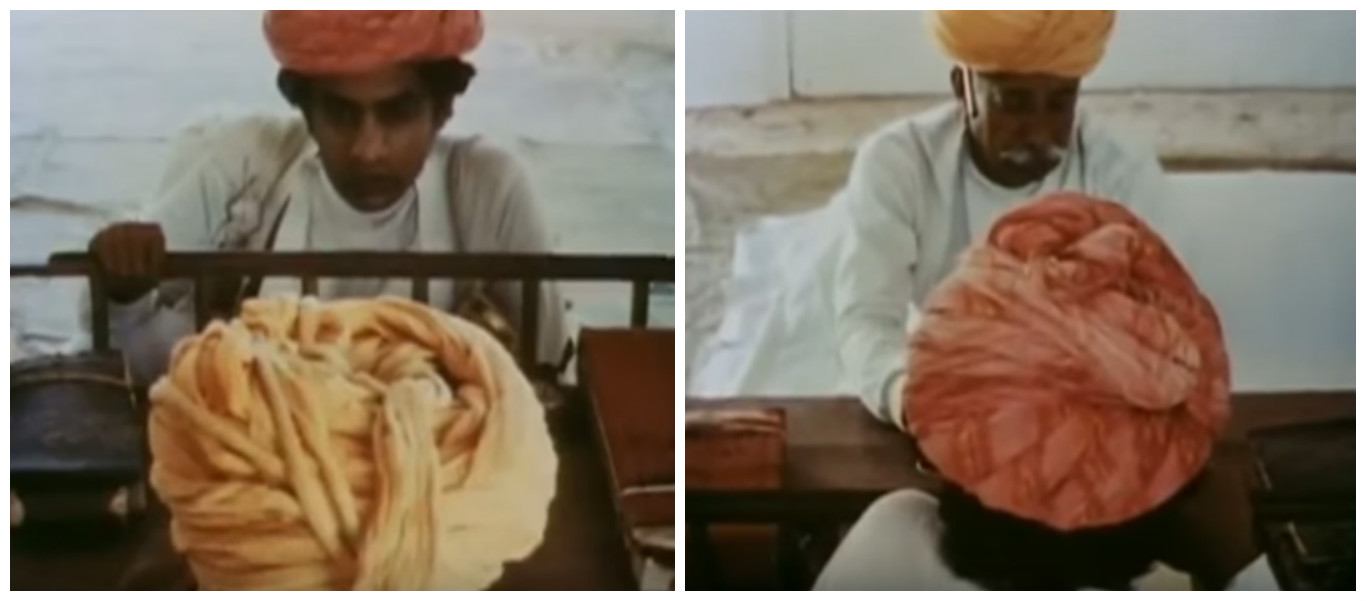
And visual motifs are liberally strewn. A bird is shown to very briefly visit the house, which looks like a set of closely hewn caverns, before flying out. This creature, much lower in evolution, has much more freedom than the sari-strait-jacketed young bride who is imprisoned within those drab walls and orthodox mores. Moreover, a static visual showing the inquisitive bird, is interesting for the way it resembles a painting.
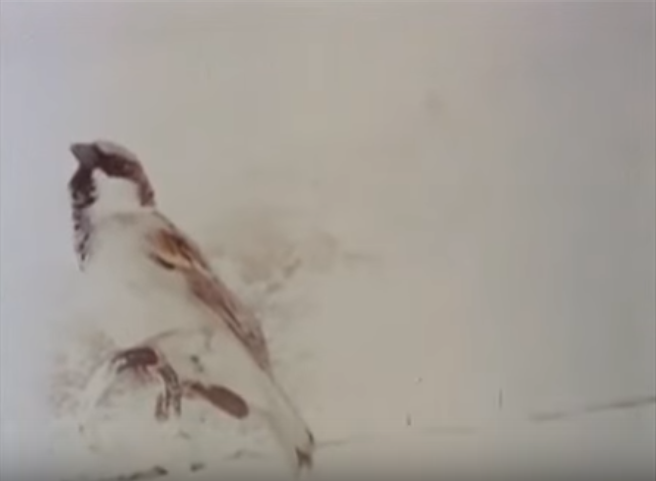
There's a sequence of the un-named young bride enjoying a ride in a swing outside. But then she doesn't seem to be really enjoying it - the pallu of the sari covers her head like a dark funeral-sheet and her head leans sideways in dolor. The scene, coming nine years after a similar much more famous one, is a clear nod to Satyajit Ray's Charulata but Kaul shows, a short while later, another gesture in his doff of hat, when the angle of camera asks whether this woman on the swing is being hanged to death.
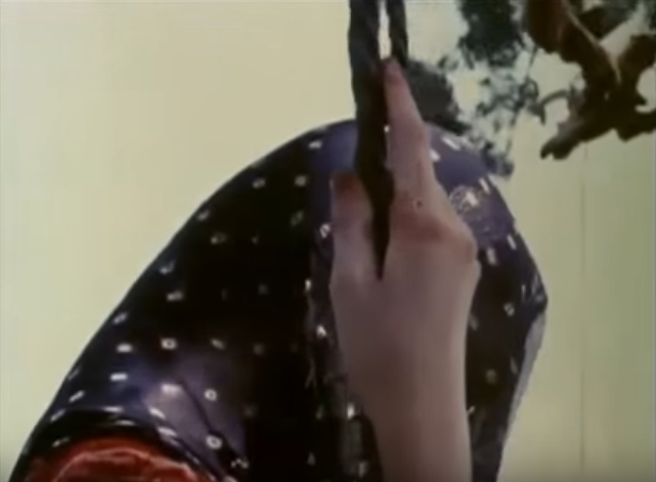
When pregnancy looms, it is introduced by a quietly dramatic static look from behind the head of the supine bride with her belly swollen, and her legs wide apart , the latter feature marking her out as a sorry baby-making-machine.
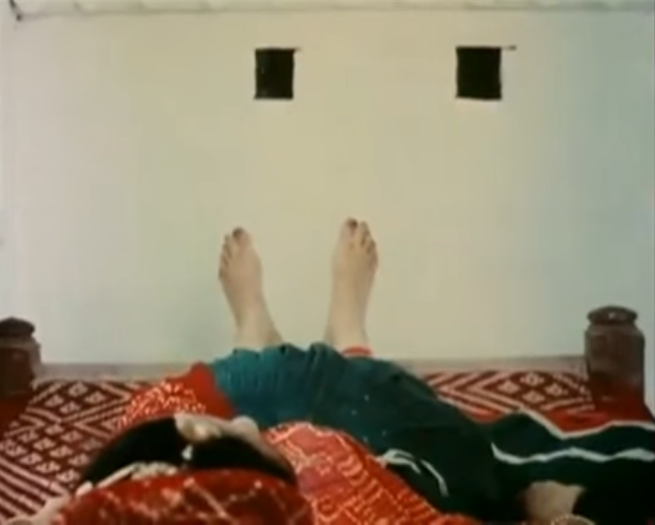
Motifs aside, there abound direct but strikingly unsual captures. A zoom shot (similar to the one I'd have extracted on my 2 megapixel phone camera years back) looks at the top of the grey courtyard walls as rain starts to hit it, but the streams of water streaking down and puddling elsewhere look like a shot of broad waterfalls.
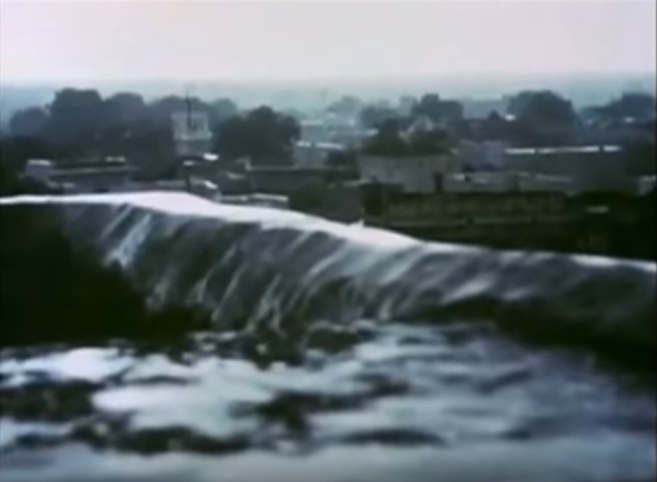
Elsewhere, Cameraman (this was the era when the lenser could still be so designated, rather than "Cinematographer" or "Director of Photography") Navroz Contractor is keen to record the simple unexpected beauty of shade against play of light.
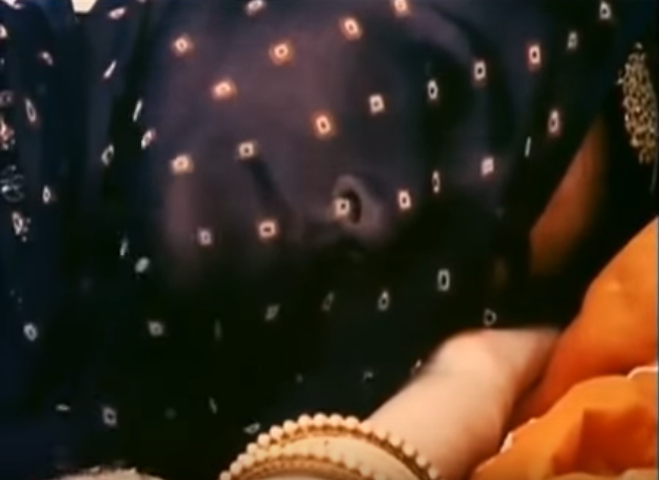
Kaul is constantly determined to play against the mores of orthodox narrative. When the time comes to differentiate between the two husbands, the answer, strangely it might seem, is verbally revealed to us right at the outset. The men are set three challanges. The second challenge which involves a lot of frenetic activity, is neatly disposed of, with ellipsis. The third and last challenge, which involves the physically impossible task of requiring a fully grown man to fit inside a leather water-flask, is done with zero special effects and just some cunning movement. In the aftermath of that sequence , the camera goes back to linger on the face of the man who judged it all. That gent now wears an expresson of doubt - did he actually do the right thing, or in trying to do the right thing has he lost something irreplaceable? Moreover, the camera again lingers on shots of the group of turbaned men all marching away in a huddle, while the soundtrack reprises the wood-'n'-metal sound of the bullock cart that first brought the conjugal pair home. What's the point of that shot of men walking away into the horizon? Is it to suggest their stupid herd metality wherein not even one talks about their decision's emotional consequence on the love triangle or what is now left of it? That entire sequence, of the villagers leaving their perimeter, to the point of them eventually returning , centers on capturing the essence of the moment rather than focusing on physical events.
As for the performances , their backbone is good, but finer nuances are obviated by Kaul's Bressonic approach where the actors are only required to be unadorned simple vessels at most, to convey the directorial plan.
Folk vocals and local instruments are employed in inspired fasion to lend bracing underlines and mystic undertows. The tone of the commentaries in the film is equally riveting. Female or male, the dialogue sparkles with native purity and emotional perpicacity. The girl's voice, virginal in its innocence and plain texture, has less screen-time but is given a cutting little soliloquy where she says " In the eyes of parents , a heap of rubbish takes more time to grow than the body their daughter ; I was barely sixteen when they began worrying about giving me away in marriage. I was able to flourish in my mother's womb but not in my father's courtyard".
The young male voice-over is particularly arresting in its stark narration. Please forgive the chauvinism in this as it is put to wonderfully quiet service - not cloying but utterly ironic - in honour of the martyred female's plight. The tone in this voice-over is gloriously inscrutable, as though it had died, and is now re-born and has remained young but omniscient, much wiser, a ghost virtually, but with the poignancy brimming over its seemingly nonchalant attitude. Elocuting in splendidly pure Hindi, its achieves its finest moment when it soliloquizes as the young wife is holding her baby and climbing up the stairs to her husband awaiting in "sweet expectation" in the aftermath of an incident. Line upon line brief but blinding beautiful is offered like dozens of wreaths weighing upon each other. The English subtitles are good (I had to make my own ones in the previous photograph) but they can't match up to the simple prose nay soaring poetry of that empyrean Hindi which you will best enjoy as fingers directly caressing the contours of your heart if you know the language itself. The young narrator nails it like no other could.
Not long before watching 'Duvidha' , I wondered whether I had seen any Indian film that boldly and excellently experimented with the very form of cinematic narrration the way Tarkovsky's 'Zerkalo' and Resnais' 'Last Year at Marienbad' had. Mani Kaul's film amply provided that answer. In the early 1970s, ambitious Indian films not prostituted to commercial concerns could still be found - three years before 'Duvidha's release, Adoor Gopalakrishnan had debuted with 'Swayamvaram' - another film about a couple who go through a lot, but with an admittedly different story and treatment. But that film was decidedly cast in the already explored cinema-verite mode, whereas Kaul's technique that employs the 'internal yet external' perspective, merits a separate article by itself in the textbook of film-making. By its beautifully subtle depiction of how a society treats its women and by its invigorating take on cinema itself, 'Duvidha' sculpts a compact but unshakeable landmark, not just in the Indian pantheon but also in world cinema. I suspect Rajat Kapoor's father liked it too.
UPN
UPNWORLD welcomes your comments.

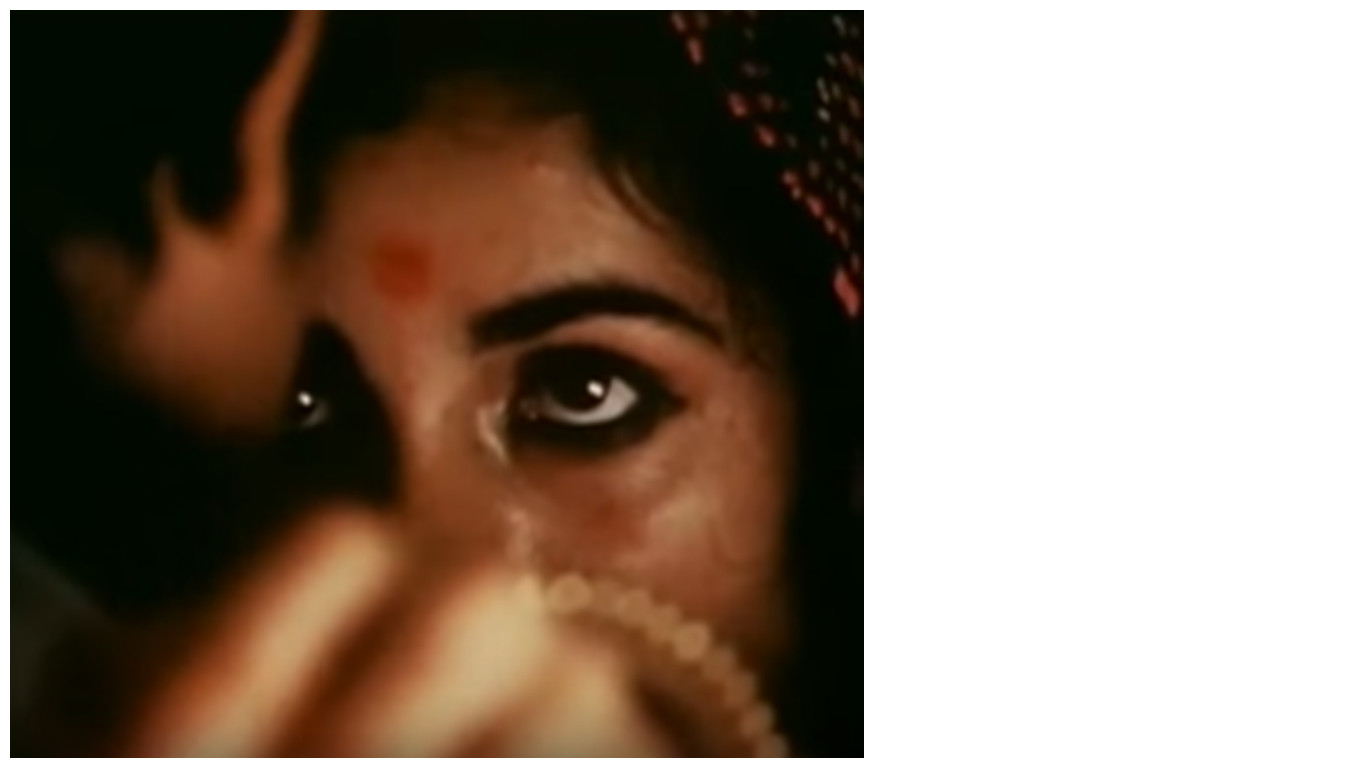

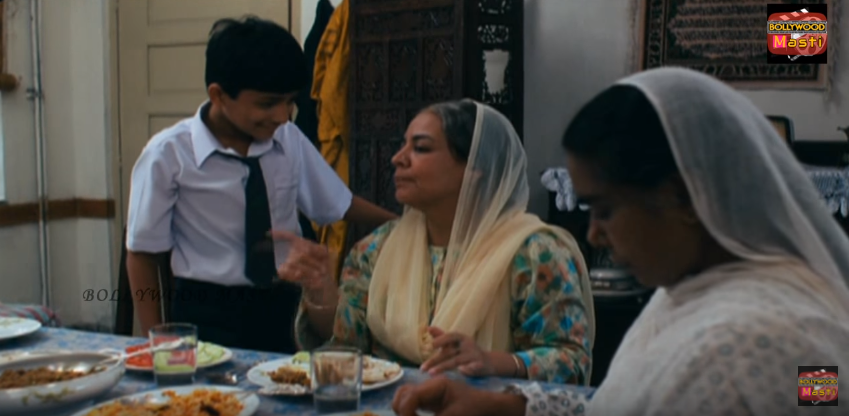
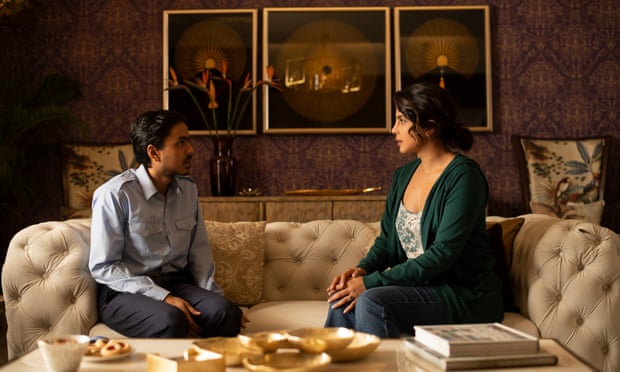
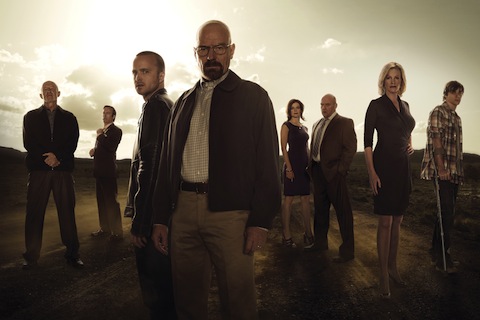




0 COMMENTS
WRITE COMMENT